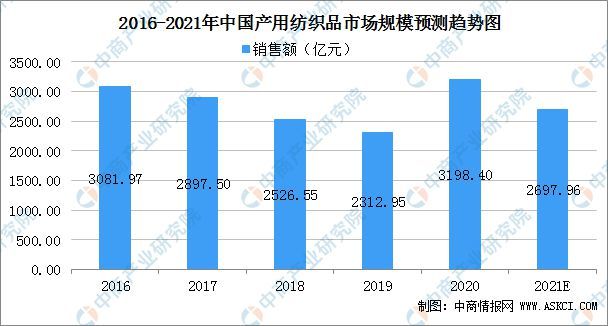The "Belt and Road" initiative unlocks new opportunities for China's industrial textile market
Release time:
2021-07-05
The textile industry can be broadly divided into three categories by application: industrial textiles, apparel textiles, and household (decorative) textiles. Currently, China mainly classifies industrial textiles by application, including 16 categories: agricultural cultivation; tarpaulins and canvas; geotextiles; labor protection and safety products; base fabrics for cultural, entertainment, and sports goods; medical and health materials and maternal and child health care materials; and national defense industrial materials.
In China, the industrial textile industry emerged in the 1950s. After half a century of development, it has become one of the three major pillar industries of China's textile industry.
Market Size
After China's accession to the WTO, driven by strong domestic and international market demand, the textile industry has entered a "fast lane," with continuous growth in industry scale and economic benefits. From 2016 to 2019, the price of industrial textiles fell, and sales also declined; in 2016, the sales of industrial textiles in China reached 308.197 billion yuan, and in 2019, it fell to 231.295 billion yuan. In 2020, the outbreak of the epidemic led to a short-term increase in the demand for emergency prevention and control materials such as masks and protective clothing, further increasing sales to 319.84 billion yuan. As the epidemic is brought under control, it is expected that the sales of industrial textiles in China will stabilize in 2021, reaching 269.796 billion yuan.

Data Source: Textile Industry Development Reports, Textile Statistical Yearbooks, and Industrial Textile Industry Development Reports of various years
Industry Development Prospects
(1) Economic Development and Improvement of Residents' Consumption Level
China's economy continues to develop, with GDP growth remaining at a high level for many years, and national income continues to grow. Currently, with the transformation and upgrading of China's social consumption structure, the consumption structure is shifting from subsistence consumption to development-oriented consumption, from traditional consumption to new consumption, and from quantity and price consumption to quality consumption upgrades. Industrial textiles have many advantages, such as high tensile strength, tear resistance, bonding strength, weather resistance, fire resistance, UV resistance, and strong airtightness. They are widely used in many fields such as sports and leisure, outdoor products, medical and health, safety protection, transportation, and construction engineering, which perfectly matches the current context of consumption upgrades, making the development prospects of China's industrial textile industry very broad.
(2) National Industrial Policies Promote Rapid Industry Development
In August 2018, the China Textile Industry Federation emphasized in the "Action Plan for the Development of Industrial Internet in the Textile Industry (2018-2020)" the need to strengthen the organization and guidance of the development of the industrial internet in the textile industry, organize industry resources such as qualified industrial clusters, professional markets, leading enterprises, and solution service providers to work together, actively explore and practice the construction and application of the industrial internet suitable for the characteristics and needs of the industry, and create a good basic environment for the development of the industrial internet in the textile industry.
In January 2020, the National Development and Reform Commission encouraged the use of non-woven, woven, knitted, braided, and other processes, as well as the combination of multiple processes and long-lasting finishing technologies, to produce functional industrial textiles in the "Guiding Catalog for Industrial Structure Adjustment (2019 Edition).
The introduction of the above-mentioned encouraging policies not only encourages the industry to actively innovate to meet the needs of various fields but also creates a good policy environment for the development of the industry, effectively promoting the stable and high-speed development of the industry.
(3) Technological Progress Continuously Expands Downstream Applications
Currently, the research and development of domestic industrial textiles mainly focuses on new raw materials, new production equipment development, functional finishing technology, and new composite processes. The improvement of related technologies has driven the improvement of product performance, enabling it to meet more and more needs in terms of both quality and functionality, thereby further expanding downstream market applications and promoting the overall upgrading of the industry.
(4) Strong Market Demand in Southeast Asia, Africa, and Other Regions, and Broad International Market Space
In recent years, with the rapid economic development of Southeast Asia, Africa, and other countries and regions along the "Belt and Road," and the moderate growth of demand in traditional markets such as Europe, the United States, Japan, and South Korea, the overall market demand will be further released, and Chinese enterprises will also have the opportunity to further expand their market space, creating favorable market conditions for the development of China's industrial textile industry.
Comprehensively build a digital intelligent laboratory and a dyeing direct-through bridge technology
The great times need a grand vision, and a grand vision needs great responsibility. Recently, Guangdong Polytechnic jointly held a seminar on "Digital Intelligent Laboratory and Dyeing Direct-Through Car Bridge Technology Digital Solution" with Guangzhou Hongjing Lab Equipment Co., LTD, exploring the digital development of the printing and dyeing industry and solutions for dyeing direct-through cars with printing and dyeing graduates. Striving to improve its technological advantages, promote the development of the digital intelligent dyeing and finishing industry, and drive the upgrading of the printing and dyeing industry chain.
On January 10, the 2022 version of OEKO-TEX ® Standard 100 was released, and the new version will come into effect on April 1, 2022.
Textile and apparel export orders have seen a significant drop in July.
Recent data released by the General Administration of Customs shows that clothing and textile exports both declined in July. In RMB terms, textile and clothing exports totaled 181.39 billion yuan, down 18.24% year-on-year and up 1.82% month-on-month, and down 4.21% compared to the same period in 2019; of which, textile exports totaled 75.06 billion yuan, down 33.73% year-on-year and down 6.90% month-on-month, but up 1.30% compared to the same period in 2019; clothing exports totaled 106.33 billion yuan, down 2.08% year-on-year and up 9.03% month-on-month, but down 7.76% compared to the same period in 2019.


